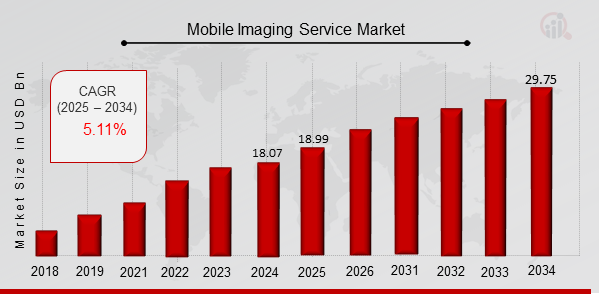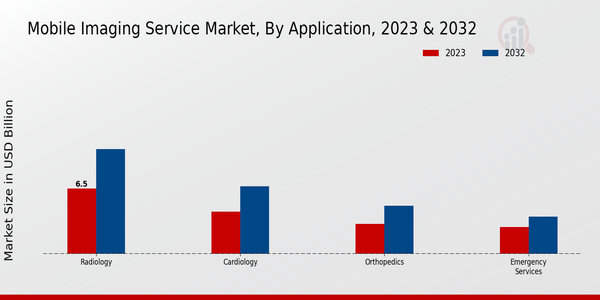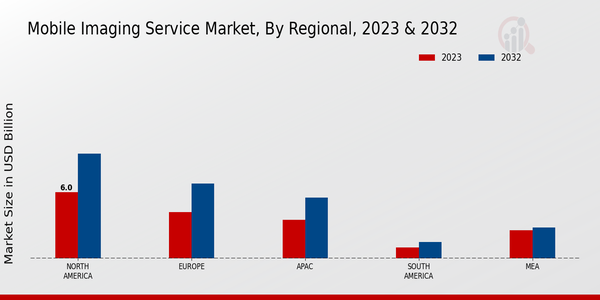Mobile Imaging Service Market Overview
As per MRFR analysis, the Mobile Imaging Service Market Size was estimated at 18.07 (USD Billion) in 2024. The Mobile Imaging Service Market Industry is expected to grow from 18.99 (USD Billion) in 2025 to 29.75 (USD Billion) till 2034, at a CAGR (growth rate) is expected to be around 5.11% during the forecast period (2025 - 2034).
Key Mobile Imaging Service Market Trends Highlighted
The mobile imaging service market is witnessing significant growth driven by several factors. The increasing need for efficient and convenient imaging solutions across various sectors, including healthcare, retail, and advertising, plays a crucial role. Technological advancements in mobile devices have enhanced imaging capabilities, enabling users to capture high-quality images and videos. This proliferation of smartphones and tablets has led to a rise in demand for mobile imaging services.
There are numerous opportunities to be explored within the mobile imaging service market. Companies can focus on developing innovative applications and tools that cater to specific customer needs. The integration of augmented reality and artificial intelligence in imaging services can create new avenues for growth.
Expanding into emerging markets can also provide substantial opportunities as these regions increasingly adopt mobile technology. By leveraging partnerships and collaborations with tech firms and healthcare organizations, businesses can enhance their offerings and provide tailored solutions that meet diverse market demands. Recent trends in the mobile imaging service market indicate an increasing emphasis on user experience and personalization.Consumers are looking for services that not only provide quality images but also offer integrated functionalities such as cloud storage and sharing capabilities. Additionally, sustainability is becoming a key consideration, with many consumers preferring environmentally friendly solutions.
As social media continues to influence consumer behavior, there is a growing demand for services that enhance visual content for online platforms. Mobile imaging services are adapting to these dynamics, ensuring they remain relevant and competitive in this evolving landscape.

Source: Primary Research, Secondary Research, MRFR Database and Analyst Review
Mobile Imaging Service Market Drivers
Increasing Demand for Home Healthcare Services
The demand for home healthcare services has significantly increased in recent years, primarily driven by an aging population and a rise in chronic diseases. Patients prefer receiving medical care in the comfort of their homes rather than visiting hospitals or clinics. This trend is strengthening the Mobile Imaging Service Market Industry, as mobile imaging services provide critical diagnostic tools that can be brought directly to the patient's location.
Services include X-rays, ultrasounds, and MRI scans, which are essential for effective patient management and treatment without the need for hospital stays. The convenience and immediacy of mobile imaging services cater to patients' needs while alleviating the burden on healthcare facilities. As the population continues to age, the demand for at-home imaging services is expected to rise, resulting in notable growth for the market.
In addition, the recent health crises have further accelerated the shift towards remote healthcare solutions, emphasizing the need for mobile imaging services as a reliable and safe option for patients.With technological advancements in imaging equipment, the accuracy and efficiency of these services are continuously improving, making them more attractive to both healthcare providers and patients alike.
Overall, the increasing preference for home healthcare, alongside the efficiencies offered by mobile imaging solutions, positions the Mobile Imaging Service Market for substantial expansion.
Technological Advancements in Imaging Technology
Technological advancements in imaging technology are playing a crucial role in the growth of the Mobile Imaging Service Market Industry. Innovations such as portable diagnostic imaging devices, digital imaging systems, and improved software applications enable mobile service providers to offer high-quality imaging services.
These advancements not only enhance the accuracy of diagnoses but also reduce the time required for imaging processes.As a result, healthcare professionals can make quicker and more informed decisions, thereby improving patient outcomes. The incorporation of AI and machine learning algorithms further enhances imaging analysis, making these mobile services even more efficient and reliable. The growing integration of advanced technologies in mobile imaging is likely to drive market growth significantly.
Growing Prevalence of Chronic Diseases
The increasing prevalence of chronic diseases, such as diabetes, cardiovascular diseases, and cancer, is a significant driver for the Mobile Imaging Service Market Industry. With more individuals requiring regular monitoring and imaging services for these conditions, the demand for accessible medical imaging has surged. Mobile imaging services offer crucial support in routine screenings and diagnostics, thereby facilitating timely intervention and treatment.
Mobile Imaging Service Market Segment Insights
Mobile Imaging Service Market Application Insights
The Mobile Imaging Service Market is set to witness significant growth in the Application segment, which includes vital areas like Radiology, Cardiology, Orthopedics, and Emergency Services. As of 2023, the overall market was valued at 16.36 USD Billion and is on track to grow substantially over the coming years. The Radiology segment leads with a valuation of 6.5 USD Billion in 2023, representing a major portion of the market due to the increasing prevalence of diagnostic imaging services and the ongoing advancement in imaging technologies.
This sub-segment plays a critical role as it provides essential diagnostic insights that drive effective patient management and treatment decisions. Following Radiology, the Cardiology segment holds a significant position in this market, valued at 4.2 USD Billion in 2023. This importance stems from the rising cases of cardiovascular diseases ly, necessitating advanced mobile imaging solutions to improve patient care and accessibility to diagnostics.
Similarly, the Orthopedics segment is valued at 3.0 USD Billion in 2023 and reflects the increasing demand for mobile imaging services tailored for musculoskeletal ailments, enhancing the efficiency of orthopedic diagnosis and treatment.On the other hand, Emergency Services represent a crucial area within the market, valued at 2.66 USD Billion in 2023. The growth in this segment can largely be attributed to the need for rapid diagnosis and immediate care, particularly in emergency medical situations, where timely imaging can significantly impact patient outcomes.
The market presents substantial opportunities as healthcare providers increasingly turn to mobile imaging services to enhance service delivery, improve patient outcomes, and optimize operational efficiencies. However, challenges remain, including the need for regulatory compliance, high initial investment costs, and technology integration issues, which can impede some market growth. Thus, the insights regarding the Mobile Imaging Service Market segmentation highlight both the significant potential and the hurdles that lie ahead.

Source: Primary Research, Secondary Research, MRFR Database and Analyst Review
Mobile Imaging Service Market Technology Insights
The Mobile Imaging Service Market revenue is projected to reach 16.36 USD Billion in 2023, reflecting significant growth opportunities within the technology segment. The market is notably driven by advancements across various imaging technologies, with imaging solutions playing a crucial role in enhancing diagnostic accuracy and patient care.
Ultrasound imaging remains a pivotal technology, particularly in obstetrics and emergency care, due to its portability and real-time imaging capabilities. Similarly, X-ray imaging continues to dominate in diagnostics, providing quick assessments for a range of conditions, especially in emergency settings.The Magnetic Resonance Imaging technology offers detailed imaging of soft tissues, thus becoming increasingly essential in oncology and neurology applications.
Computerized Tomography is also significant for its ability to provide comprehensive cross-sectional images, facilitating clearer diagnosis in trauma cases. The Mobile Imaging Service Market segmentation showcases a diverse application of these technologies, addressing the growing demand for rapid diagnostic solutions. Alongside the increasing emphasis on home healthcare and remote diagnostics, the market is poised for sustained growth driven by these key imaging technologies.
Mobile Imaging Service Market End User Insights
The Mobile Imaging Service Market is projected to reach a valuation of 16.36 billion USD in 2023, with various end users contributing significantly to this growth. Hospitals take a prominent role within this market, driven by the increasing demand for quick and accessible imaging services that enhance patient outcomes.
Diagnostic centers also play a crucial role, as they provide specialized services and advanced imaging technologies essential for accurate diagnosis. Ambulatory surgical centers are emerging as significant contributors due to the rising preference for outpatient procedures, where immediate imaging support can streamline patient care.
Home care services are gaining traction, particularly with the aging population and growing chronic health issues, allowing patients to receive necessary imaging without leaving their homes. The Mobile Imaging Service Market segmentation highlights the strength of hospitals and diagnostic centers while also recognizing the opportunities for in-home care and ambulatory surgical centers, reflecting the evolving needs of the healthcare sector.
Mobile Imaging Service Market Service Type Insights
The Mobile Imaging Service Market is experiencing steady growth, with a projected value of 16.36 USD Billion in 2023 and a significant rise expected by 2032. The market segmentation reveals key service types, including Mobile MRI Services, Mobile CT Services, Mobile Ultrasound Services, and Mobile X-ray services, all of which play a crucial role in enhancing healthcare accessibility.
Mobile MRI Services have gained traction due to their ability to provide detailed imaging in various locations, addressing patient needs effectively. Similarly, Mobile CT Services are prominent for their rapid diagnostic capabilities, making them essential in emergency settings.Mobile Ultrasound Services dominate, particularly in prenatal care and other specialized medical fields, showcasing flexibility and convenience.
Mobile X-ray services serve as a fundamental component of mobile imaging due to their widespread use and ability to deliver quick results, driving demand significantly in both rural and urban healthcare. Factors such as the increasing aging population, the need for immediate diagnostics, and advancements in imaging technology fuel the market's growth while posing some challenges, including regulatory compliance and financing.
Mobile Imaging Service Market Regional Insights
The Mobile Imaging Service Market is projected to showcase diverse growth across various regional segments. In 2023, North America led this market with a valuation of 6.0 USD billion, reflecting its majority holding and advanced healthcare infrastructure. By 2032, this segment is anticipated to reach 9.5 USD billion, reinforcing its significant position in the industry.
Following North America, Europe is valued at 4.2 USD billion in 2023 and is expected to grow to 6.8 USD billion by 2032, driven by increased healthcare expenditures and technological advancements.The Asia-Pacific (APAC) region, currently valued at 3.5 USD billion in 2023, is expected to witness growth to 5.5 USD billion by 2032, largely due to rising healthcare access and population demands.
South America and the Middle East Africa (MEA) are comparatively smaller segments, valued at 1.0 USD billion and 2.56 USD billion in 2023, respectively, with projections of reaching 1.5 USD billion and 2.8 USD billion by 2032. Despite their smaller market sizes, these regions present unique opportunities for growth as healthcare solutions adapt to varying patient needs and infrastructural developments.Each region's performance within the Mobile Imaging Service Market showcases its unique challenges and potential, influenced by factors such as population growth, technological adoption, and healthcare policies.

Source: Primary Research, Secondary Research, MRFR Database and Analyst Review
Mobile Imaging Service Market Key Players and Competitive Insights
The Mobile Imaging Service Market is experiencing significant transformation propelled by advancements in technology and an increasing demand for accessible healthcare solutions. As healthcare providers strive to improve patient outcomes and enhance operational efficiency, mobile imaging services have emerged as a vital component in the delivery of diagnostic imaging, particularly in underserved and remote locations.
This market is characterized by a landscape where numerous key players compete by offering innovative solutions, advanced equipment, and comprehensive services that cater to the diverse needs of healthcare facilities. Factors such as regulatory standards, technological innovations, and strategic collaborations are crucial in shaping the competitive framework of the mobile imaging service market.
Companies are increasingly focusing on integrating artificial intelligence and cloud computing to enhance operations, improve diagnostics, and streamline workflows, ultimately driving the market forward.Carestream Health stands out in the Mobile Imaging Service Market with its robust portfolio of imaging solutions. The company is known for its commitment to innovation and the development of cutting-edge mobile imaging technologies that cater to a range of healthcare settings.
Carestream Health leverages its strong research and development capabilities to produce highly efficient and portable imaging systems, enabling healthcare providers to deliver prompt and accurate diagnoses. Its reputation for reliability and performance has allowed it to establish a solid market presence, especially in the fields of radiography and ultrasound services.
Additionally, the company emphasizes customer support and service, ensuring that clients can seamlessly integrate mobile imaging into their existing workflows. Carestream Health's strategic initiatives and focus on improving patient care position it favorably against its competitors in the mobile imaging services sector.Siemens Healthineers is another significant player in the Mobile Imaging Service Market.
The company is renowned for its advanced imaging technologies that facilitate high-quality diagnostics across various applications. Siemens Healthineers employs a unique approach that combines innovation with a strong understanding of customer needs, enhancing its capacity to deliver mobile imaging solutions tailored to meet the demands of healthcare providers. With a commitment to advancing healthcare technology, Siemens Healthineers continues to strengthen its position in the mobile imaging service market, focusing on expanding its capabilities and offerings to provide comprehensive imaging solutions that address current and emerging healthcare challenges.
Key Companies in the Mobile Imaging Service Market Include
- Carestream Health
- Siemens Healthineers
- Canon Medical Systems
- GE Healthcare
- Philips Healthcare
- CureMetrix
- Hologic
- Fujifilm Holdings
- Radiology Partners
- AgfaGevaert
- Densitas
- eRAD
- Intelerad Medical Systems
- Zebra Medical Vision
Mobile Imaging Service Market Industry Developments
Recent developments in the Mobile Imaging Service Market have shown significant growth, particularly in advanced imaging technologies embracing mobile solutions. Companies such as Carestream Health, Siemens Healthineers, and Canon Medical Systems are investing heavily in innovative mobile imaging modalities to enhance healthcare delivery, especially in remote areas.
GE Healthcare and Philips Healthcare are expanding their mobile imaging portfolios, focusing on portable ultrasound and X-ray systems that provide high-quality imaging with increased accessibility for patients. The merger and acquisition landscape has also been active, with firms like Fujifilm Holdings and Hologic pursuing strategic collaborations to bolster their market presence and technology capabilities.
CureMetrix, alongside Radiology Partners, is making strides in artificial intelligence integration, which is reshaping diagnostic accuracy in mobile imaging. Additionally, the market valuation continues to see upward momentum, driven by the rising demand for mobile health services, particularly in the wake of ongoing health challenges. This demand is further amplified by regulatory support promoting telehealth and remote diagnostics, creating opportunities for companies such as AgfaGevaert, Densitas, eRAD, Intelerad Medical Systems, and Zebra Medical Vision to advance their offerings in this evolving market landscape.
Mobile Imaging Service Market Segmentation Insights
Mobile Imaging Service Market Application Outlook
- Radiology
- Cardiology
- Orthopedics
- Emergency Services
Mobile Imaging Service Market Technology Outlook
- Ultrasound Imaging
- X-Ray Imaging
- Magnetic Resonance Imaging
- Computerized Tomography
Mobile Imaging Service Market End User Outlook
- Hospitals
- Diagnostic Centers
- Ambulatory Surgical Centers
- Home Care
Mobile Imaging Service Market Service Type Outlook
- Mobile MRI Services
- Mobile CT Services
- Mobile Ultrasound Services
- Mobile X-Ray Services
Mobile Imaging Service Market Regional Outlook
- North America
- Europe
- South America
- Asia-Pacific
- Middle East and Africa
| Report Attribute/Metric |
Details |
|
Market Size 2024
|
18.07 (USD Billion)
|
|
Market Size 2025
|
18.99 (USD Billion)
|
|
Market Size 2034
|
29.75 (USD Billion)
|
|
Compound Annual Growth Rate (CAGR)
|
5.11 % (2025 - 2034)
|
|
Report Coverage
|
Revenue Forecast, Competitive Landscape, Growth Factors, and Trends
|
|
Base Year
|
2024
|
|
Market Forecast Period
|
2025 - 2034
|
|
Historical Data
|
2020 - 2024
|
| Market Forecast Units |
USD Billion |
| Key Companies Profiled |
Carestream Health, Siemens Healthineers, Canon Medical Systems, GE Healthcare, Philips Healthcare, CureMetrix, Hologic, Fujifilm Holdings, Radiology Partners, AgfaGevaert, Densitas, eRAD, Intelerad Medical Systems, Zebra Medical Vision |
| Segments Covered |
Application, Technology, End User, Service Type, Regional |
| Key Market Opportunities |
Increased demand for telehealth services, Expansion in home healthcare solutions, Growth of portable imaging technologies, Rising geriatric population, Advancements in imaging software integration |
| Key Market Dynamics |
Technological advancements, Rising demand for convenience, Growing geriatric population, Cost-effective healthcare solutions, Improved healthcare accessibility |
| Countries Covered |
North America, Europe, APAC, South America, MEA |
Frequently Asked Questions (FAQ) :
The Global Mobile Imaging Service Market is expected to be valued at 29.75 USD Billion in 2034.
The market is projected to have a CAGR of 5.11% from 2025 to 2034.
North America holds the dominant market share, valued at 6.0 USD Billion in 2023.
The market size for Radiology applications is expected to reach 10.4 USD Billion by 2032.
Key players include Carestream Health, Siemens Healthineers, Canon Medical Systems, and GE Healthcare.
The projected market size for Cardiology applications is anticipated to be 6.7 USD Billion in 2032.
The APAC region is expected to grow to 5.5 USD Billion in 2032 from 3.5 USD Billion in 2023.
Emergency Services applications are projected to reach a market size of 3.7 USD Billion in 2032.
Key challenges include technological advancements, regulatory compliance, and competition among major players.
The North American market is expected to reach 9.5 USD Billion in 2032.

















